Beginner’s guide to the best Sim Racing setup and equipment
Starting your sim racing journey requires three essential components: a gaming wheel and pedals, a sim racing cockpit or mounting solution, and a capable PC or console.
Budget setups begin around $500-600 with options like the Logitech G29/G920, while premium configurations can exceed $3000 for professional-grade equipment.
The world of sim racing has exploded in popularity over recent years, transforming from a niche hobby into a legitimate motorsport discipline.
Whether you’re drawn to the precision of Formula 1, the strategy of endurance racing, or the raw excitement of rally stages, building the right setup is crucial for maximizing your experience and performance on track.
Having spent countless hours researching, testing, and upgrading my own sim racing setup over the past five years, I’ve learned that the key to success isn’t necessarily spending the most money – it’s understanding which components matter most for your specific goals and budget. This comprehensive guide will walk you through everything you need to know to build your first sim racing setup, avoid common beginner mistakes, and create a foundation that can grow with your skills.
Understanding Sim Racing: More than just gaming
Sim racing represents the intersection of cutting-edge technology and motorsport passion. Unlike arcade racing games that prioritize fun over realism, racing simulators aim to replicate the physics, handling characteristics, and competitive environment of real-world motorsport. This means every component of your setup – from the force feedback in your steering wheel to the load cell pressure in your brake pedal – plays a crucial role in creating an authentic driving experience.
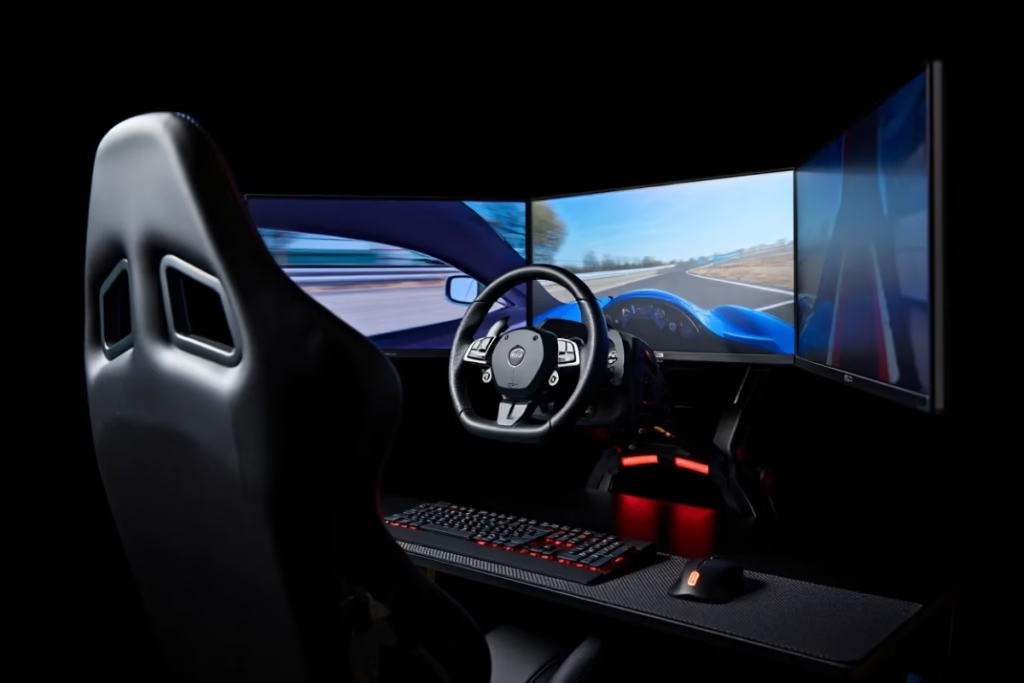
When I first discovered sim racing through a friend’s basic Logitech setup, I was immediately struck by how different it felt from traditional racing games. The force feedback wheel communicated tire grip, road surface changes, and vehicle dynamics in ways that a game controller simply couldn’t match. That initial experience convinced me that sim racing wasn’t just about entertainment – it was about genuine skill development and competition.
Modern racing simulators like iRacing, Assetto Corsa Competizione, and rFactor 2 utilize sophisticated physics engines that account for factors like tire temperature, aerodynamic effects, and suspension geometry. This level of detail means that the skills you develop in sim racing can genuinely translate to real-world driving, which is why professional drivers and racing schools increasingly use simulators for training.
Essential components: Building your foundation
Racing Wheels: The heart of your setup
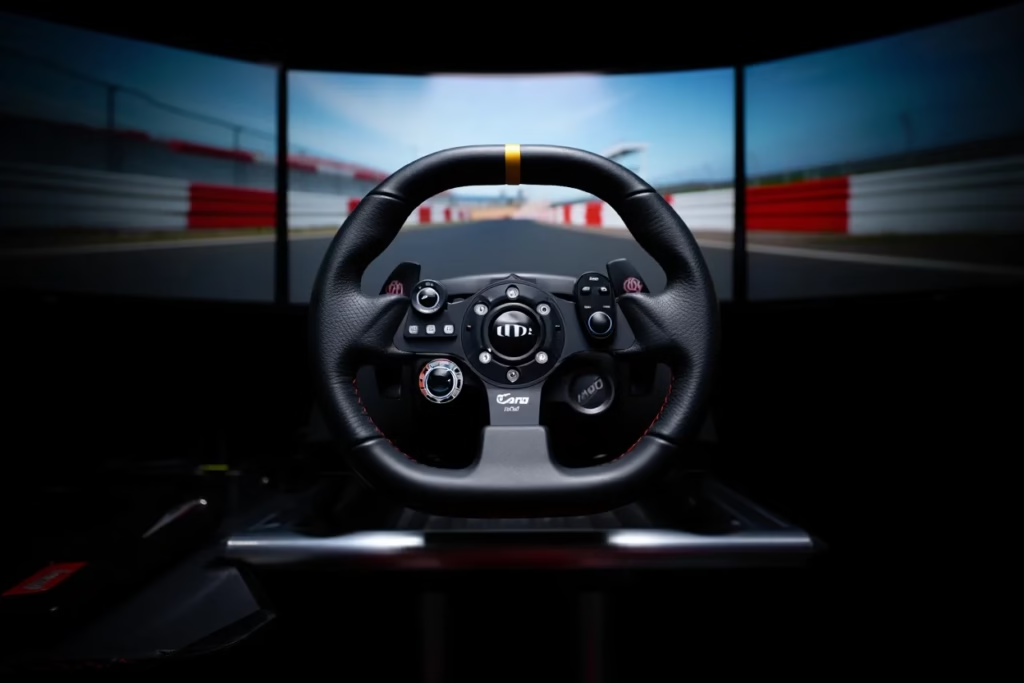
The racing wheel serves as your primary interface with the virtual car, making it arguably the most important component of any sim racing setup. When evaluating wheels, you’ll encounter two main drive systems: belt-drive and direct-drive configurations.
Belt-drive wheels like the Logitech G29 and G920 remain excellent entry points for beginners. I started my sim racing journey with a G29, and despite owning much more expensive equipment now, I still recommend it to newcomers. The G29/G920 offers solid force feedback, robust construction, and compatibility with both PC and consoles at a price point that won’t break the bank. These wheels typically retail for $200-250 and include a three-pedal set, making them exceptional value for money.
For those ready to step up, direct-drive wheels like the Fanatec CSL DD or Moza R5 provide significantly more precise and powerful force feedback. Direct-drive systems eliminate the belt mechanism, connecting the wheel directly to the motor for instantaneous response and higher fidelity feedback. While more expensive ($800-1500), these systems offer a noticeable improvement in immersion and precision that becomes apparent during longer racing sessions.
The wheel diameter and rim material also impact your experience. Most entry-level wheels feature 28-30cm diameters with synthetic leather or rubber grips, while premium options offer authentic suede wrapping and larger diameters that better replicate real race cars.
Pedals: Where precision meets performance
Sim racing pedals represent one of the most impactful upgrades you can make to your setup. The difference between basic potentiometer pedals and quality load cell systems is immediately noticeable and can significantly improve your lap times and consistency.
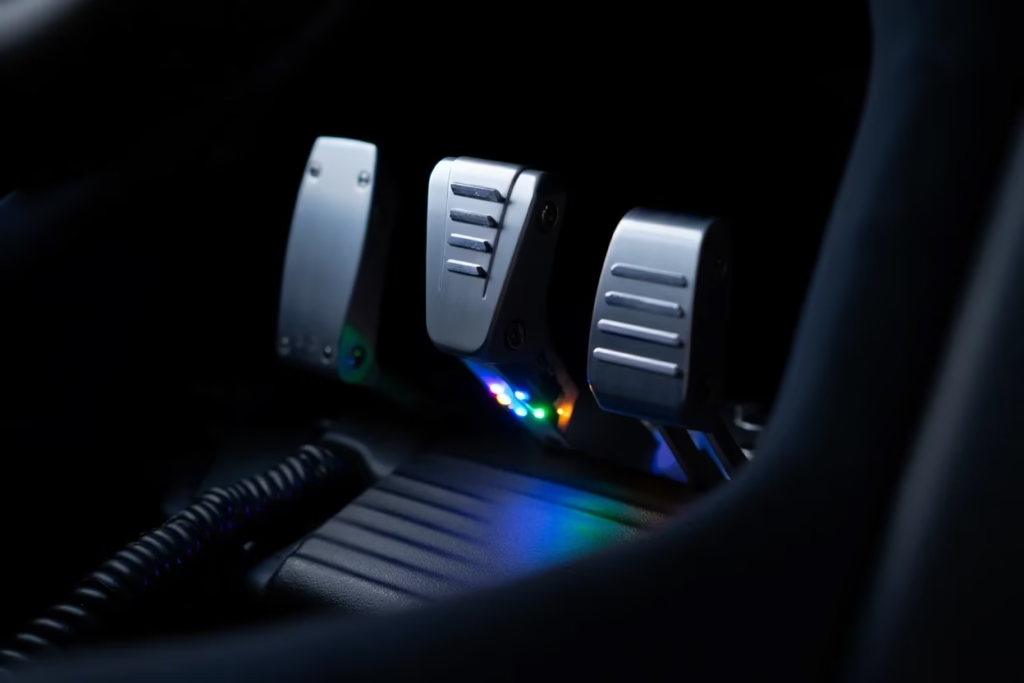
Potentiometer pedals, found in most entry-level wheel sets, measure pedal position rather than applied force. While functional, they lack the precision and realistic feel of more advanced systems. I remember struggling with consistent braking on my original G29 pedals, particularly during long endurance races where fatigue would affect my pedal positioning.
Load cell pedals measure the force you apply rather than pedal travel distance, closely mimicking real car brake systems. This technology allows for much more consistent and precise braking, as your muscle memory learns to apply specific force levels rather than reaching particular pedal positions. Popular options include the Thrustmaster T-LCM pedals ($160) for budget-conscious buyers and the Heusinkveld Sprint pedals ($520) for serious enthusiasts5.
Higher-end pedal sets like the Simucube ActivePedals ($2400+) even incorporate force feedback directly into the pedals, providing tactile information about tire grip, ABS activation, and traction control intervention. While expensive, these systems represent the cutting edge of sim racing technology.
Cockpits and mounting solutions: Stability and comfort
A proper sim racing cockpit provides the stable platform necessary for precise control and comfortable extended racing sessions. Your mounting solution directly impacts the effectiveness of your wheel and pedals, making it a crucial consideration rather than an afterthought.
For beginners on tight budgets, simple wheel stands or desktop clamps can suffice initially. However, I quickly discovered that a wobbly setup leads to inconsistent inputs and fatigue during longer races. The constant micro-adjustments needed to compensate for movement become mentally exhausting and hurt performance.
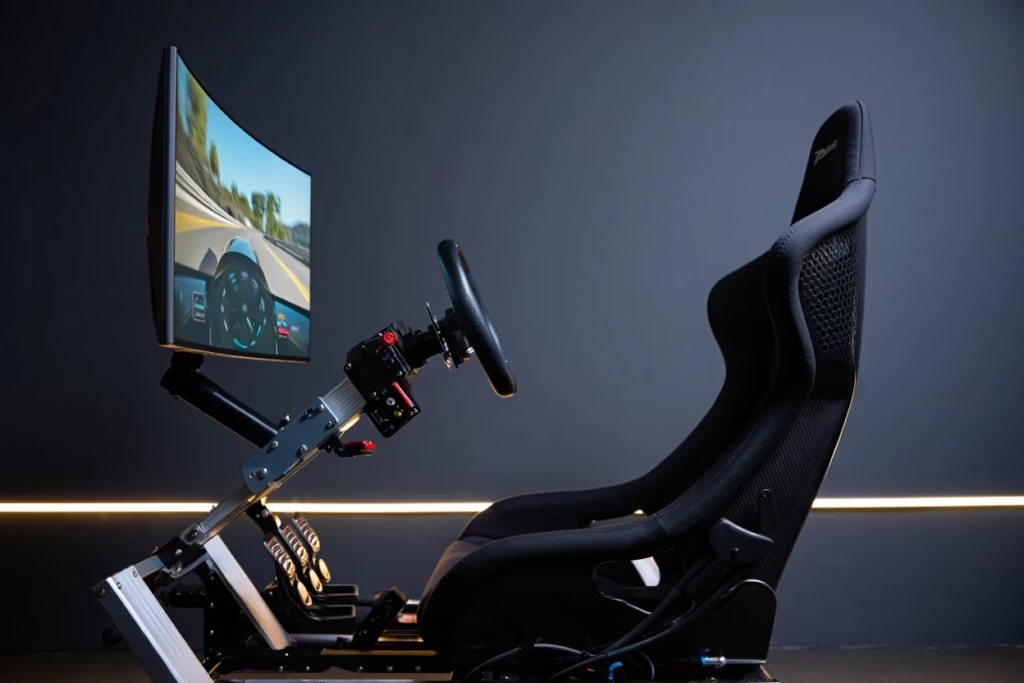
The Next Level Racing Victory Simulator Cockpit represents the gold standard for versatility and build quality. Its powder-coated steel construction provides zero flex even under aggressive direct-drive wheel forces, while its modular design accommodates everything from casual gaming to professional esports competition. At around $800-1000, it’s a significant investment but one that will accommodate any future upgrades.
Budget-friendly alternatives like the RACGTING Racing Simulator Cockpit offer excellent value for newcomers. These steel-frame designs provide adequate rigidity for entry-level equipment while maintaining upgrade compatibility as your setup evolves.
Adjustability is key regardless of your budget. Look for cockpits that allow pedal position adjustment, seat positioning, and wheel height modifications. I’ve found that even small adjustments to driving position can significantly impact comfort and performance during extended racing sessions.
PC requirements: Powering your virtual garage
Modern sim racing titles demand substantial computing power to deliver the visual fidelity and physics accuracy that make the experience compelling.
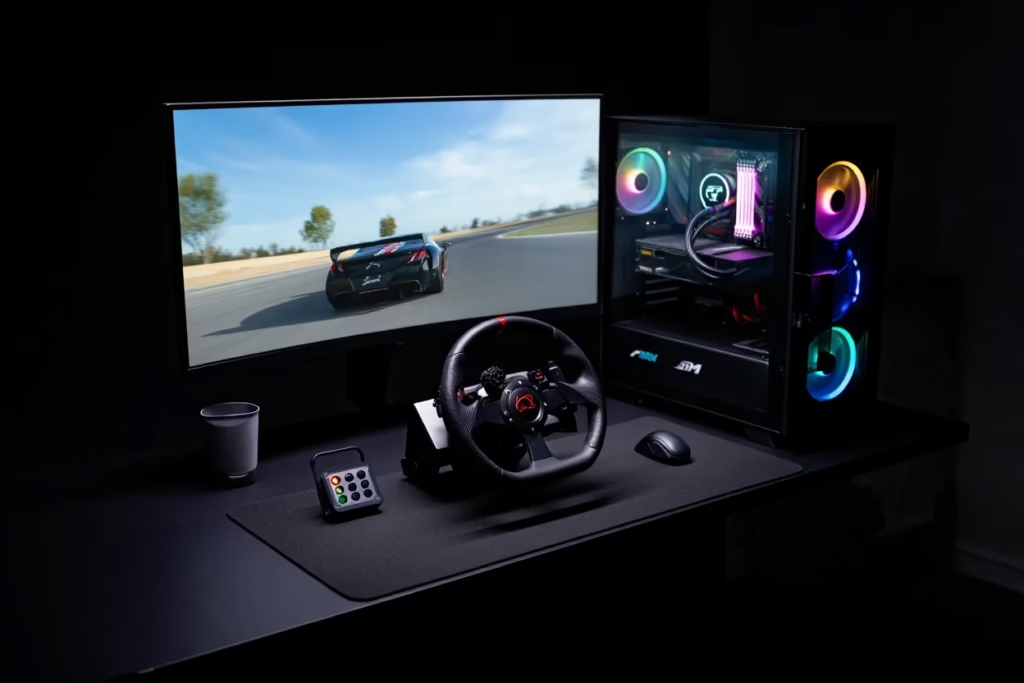
Unlike many games where you can compromise on settings, sim racing benefits enormously from high frame rates and detailed graphics that provide crucial visual information for precision driving.
Processor requirements
CPU selection is particularly important for sim racing, as physics calculations, AI behavior, and telemetry processing place heavy demands on the processor. I recommend starting with at least an Intel Core i7-14700K or AMD Ryzen 9 7900X for modern sim racing titles. These processors provide sufficient cores and clock speeds to handle demanding simulations while maintaining high frame rates.
Racing in crowded multiplayer sessions, particularly in iRacing’s popular series, can be surprisingly CPU-intensive. During my early days with an underpowered processor, I experienced frustrating frame drops during race starts that affected my ability to react quickly to developing situations.
Graphics card considerations
The graphics card handles the visual rendering that brings your virtual racing world to life. For single-monitor setups at 1080p, an RTX 4070 or equivalent provides excellent performance with high detail settings. Triple-monitor configurations or VR headsets require significantly more graphics power, with RTX 4080 or higher recommended for optimal performance.
Ray tracing support in modern sim racing titles like Assetto Corsa Competizione adds incredible visual realism but demands substantial GPU power. While not essential for competitive performance, the enhanced lighting and reflections create a more immersive experience that’s particularly noticeable during different weather conditions and time-of-day transitions.
Memory and storage
32GB of RAM has become the sweet spot for modern sim racing, particularly if you plan to run streaming software, voice chat, and telemetry applications simultaneously. Racing simulators with detailed car models and high-resolution textures benefit from generous memory allocation.
SSD storage is essential for reasonable loading times, with 2TB capacity recommended for serious sim racers. iRacing alone can consume several hundred gigabytes with all content installed, and other simulators require similar storage commitments.
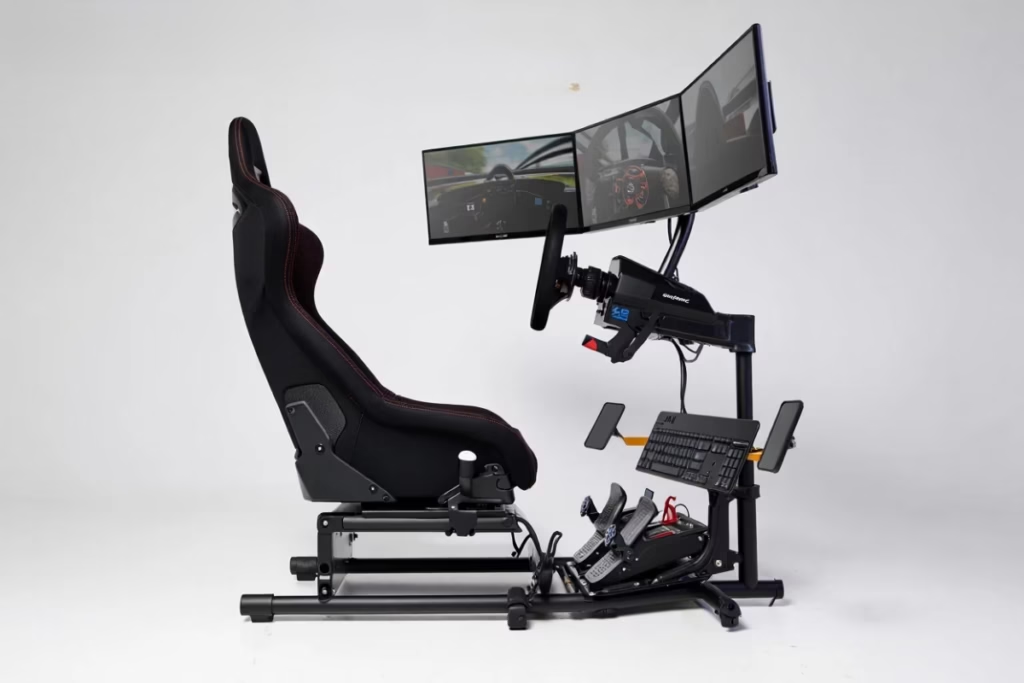
Budget-conscious setup recommendations
Entry-level setup ($500-700)
For newcomers testing the waters, a basic but functional setup can be assembled affordably:
- Logitech G29/G920: $200-250 (used prices often $150-200).
- Wheel stand or desktop clamp: $50-100.
- Existing PC (minimum GTX 1660/RX 580 level graphics).
- Single monitor setup using existing display.
This configuration provides genuine sim racing capability while minimizing financial commitment. I started with a very similar setup and enjoyed hundreds of hours of racing before feeling compelled to upgrade.
Mid-range setup ($1500-2500)
This price range offers significant performance improvements and future upgrade potential:
- Moza R5 Bundle: $1900-2100.
- Playseat Challenge: $300-400.
- Dedicated gaming PC: $1000-1500 (RTX 4060 Ti level).
- 32-inch monitor: $300-500.
The jump from entry-level to mid-range equipment is substantial and immediately noticeable. Better force feedback, improved pedal precision, and higher frame rates combine to create a much more engaging and competitive experience.
Premium setup ($3000+)
For enthusiasts ready to invest in top-tier equipment:
- Fanatec DD2 or Simucube Pro 2: $1500-2000.
- Heusinkveld Ultimate+ Pedals: $1100.
- Next Level Racing F-GT Pro: $800-1000.
- High-end PC: $2000-3000.
- Triple monitor setup or VR headset: $1000-2000.
Premium setups provide professional-level capabilities with virtually unlimited upgrade potential. The precision and immersion available at this level genuinely rivals real racing car experiences.
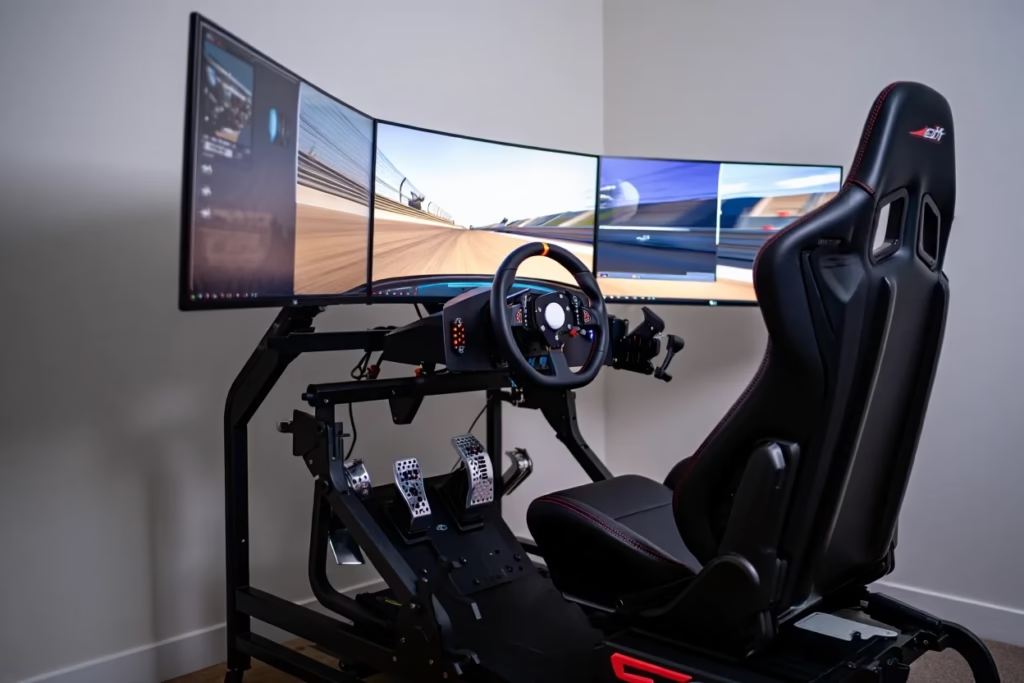
Advanced equipment and upgrades
Shifters and additional controls
H-pattern shifters and sequential shifters add significant immersion when driving appropriate vehicle types. The Fanatec ClubSport SQ V1.5 offers both shifting modes in a single unit, making it ideal for drivers who enjoy multiple racing disciplines.
Racing primarily in iRacing, I find myself constantly switching between GT cars that use paddle shifters and vintage touring cars that require manual shifting with a clutch.
Handbrakes become essential for rally simulation, while button boxes provide quick access to car functions during endurance racing. These accessories might seem unnecessary initially, but they dramatically enhance the authenticity of specific racing disciplines.
Audio solutions
Quality audio equipment often gets overlooked but significantly impacts immersion and performance. Engine sounds, tire squeal, and environmental audio provide crucial information about vehicle behavior and track conditions. I initially underestimated audio importance until experiencing races with high-quality headphones – the additional sensory information genuinely improved my driving consistency.
Bass shakers and tactile transducers add physical vibration feedback that simulates engine vibrations, gear shifts, and track surface changes. While not essential, these systems bridge the gap between visual simulation and physical sensation in ways that enhance the overall experience.
Virtual reality integration
VR headsets represent perhaps the most transformative upgrade available to sim racers. The Bigscreen Beyond and similar headsets provide unparalleled immersion, allowing natural head movement for checking mirrors, assessing corner entry points, and maintaining spatial awareness during close racing.
The transition to VR requires adjustment – initial sessions can be disorienting, and some users experience motion sickness. However, after adapting to VR racing, returning to monitor-based setups feels limiting. The three-dimensional perspective and natural head tracking provide advantages that are difficult to quantify but immediately apparent during competitive racing.
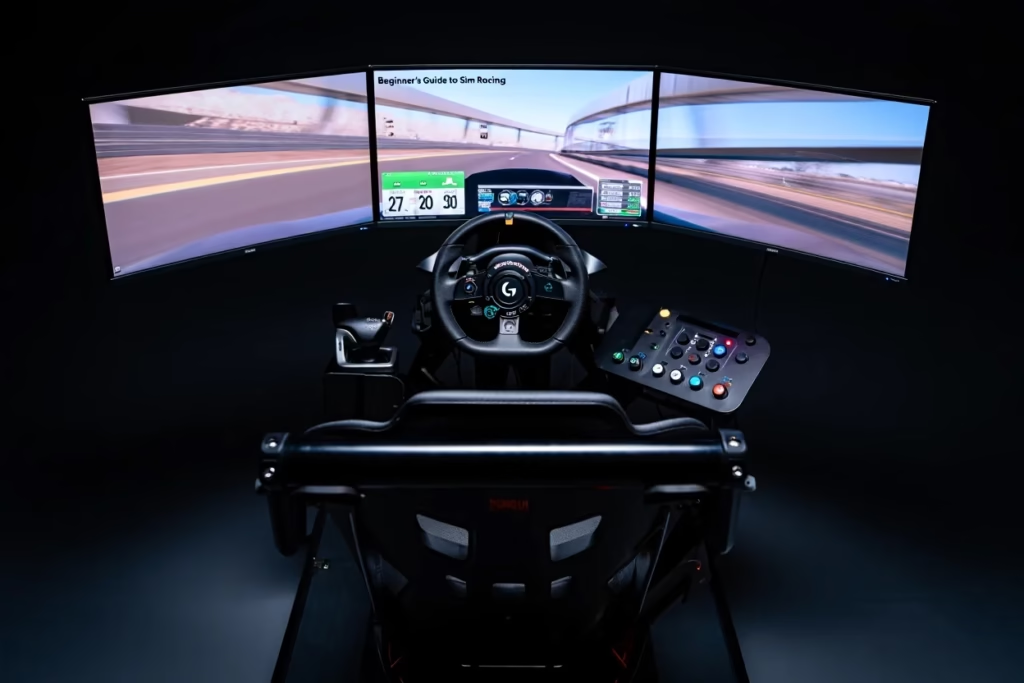
Getting started: First steps and essential tips
Choosing your first simulator
- Assetto Corsa Competizione offers an excellent introduction to serious sim racing with its focus on GT3 and GT4 racing. The physics are authentic but forgiving enough for beginners, while the AI provides quality offline racing for skill development.
- iRacing represents the pinnacle of competitive online racing but requires a subscription model and additional content purchases. The structured license progression system and organized racing series make it ideal for drivers seeking genuine competition, though the learning curve can be steep.
- Forza Motorsport bridges the gap between arcade and simulation, offering accessibility while maintaining reasonable physics accuracy. It’s an excellent choice for console users or those preferring a more casual approach to sim racing.
Essential skills development
- Smooth inputs form the foundation of fast sim racing. Unlike arcade games that reward aggressive steering and braking, simulators punish sudden movements with loss of grip and control. I spent my first months focusing exclusively on smooth, progressive inputs rather than outright speed – a philosophy that paid dividends as I progressed to more competitive racing.
- Trail braking represents one of the most important advanced techniques to master. This involves gradually releasing brake pressure while entering corners, transferring vehicle weight to maintain optimal grip throughout the turning process. It took me months to become comfortable with trail braking, but the lap time improvements were immediately apparent.
- Consistency trumps raw speed in competitive racing. Learning to hit your marks lap after lap, managing tire degradation, and maintaining concentration during long races are skills that separate casual sim racers from serious competitors.
Maintenance and longevity considerations
- Quality sim racing equipment can provide years of reliable service with proper care. Force feedback wheels require occasional calibration and cleaning, while load cell pedals benefit from periodic sensor maintenance. I’ve found that investing in quality equipment initially often proves more economical than repeatedly upgrading cheaper alternatives.
- Software updates and driver maintenance are ongoing responsibilities that affect system performance and compatibility. Most manufacturers provide regular updates that improve functionality and add features, making it worthwhile to stay current with firmware versions.
- Ergonomic considerations become increasingly important as session lengths increase. Proper seat positioning, adequate lumbar support, and appropriate monitor placement help prevent fatigue and maintain focus during extended racing sessions.
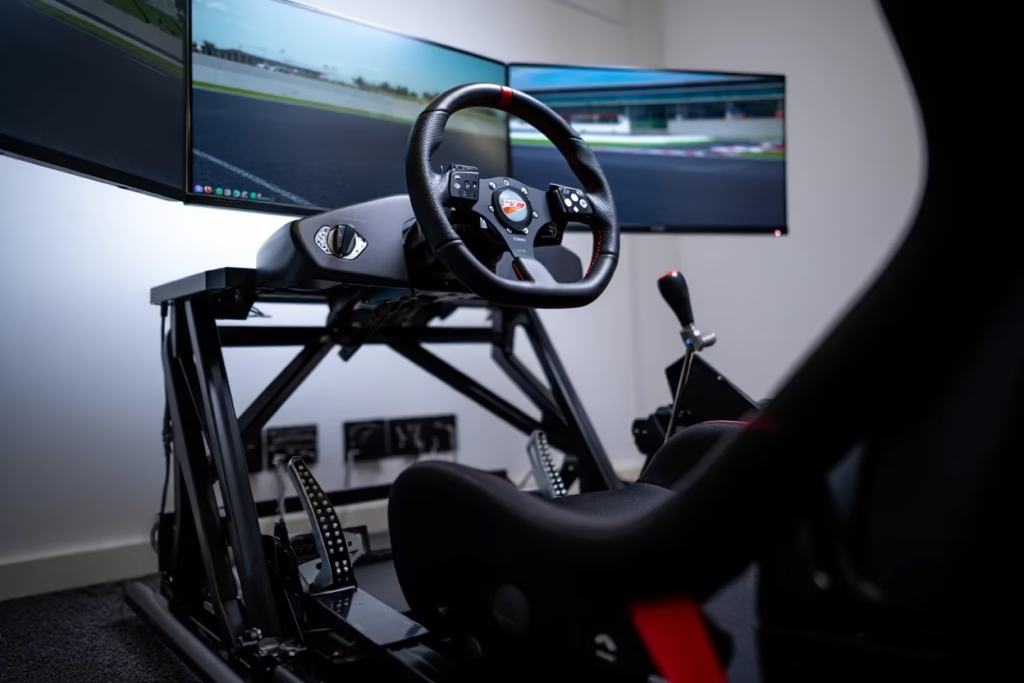
Conclusion: Building your perfect setup
Creating the ideal sim racing setup is a journey rather than a destination. My own setup has evolved continuously over five years, with each upgrade teaching valuable lessons about what matters most for different types of racing. The key is starting with a solid foundation that provides genuine simulation capability while allowing for future expansion as your skills and interests develop.
Remember that the most expensive equipment won’t automatically make you faster – developing fundamental driving skills remains paramount. However, quality equipment does provide better feedback, improved precision, and enhanced immersion that can accelerate your learning process and increase enjoyment.
Whether you’re starting with a basic wheel and pedal set or jumping directly into a premium configuration, the sim racing community offers incredible depth, competition, and camaraderie. The journey from fumbling with basic controls to competing in organized championships provides a uniquely rewarding experience that combines technical knowledge, athletic skill, and pure excitement.
Start with equipment that fits your current budget and commitment level, focus on developing smooth and consistent driving techniques, and gradually upgrade components as your passion and skills grow. The world of sim racing offers something for everyone, from casual weekend warriors to aspiring professional drivers – and building the right setup is the first step toward discovering where this incredible hobby might take you.